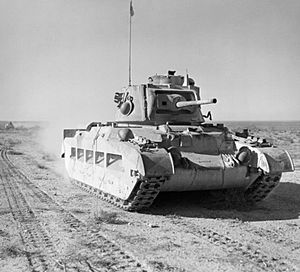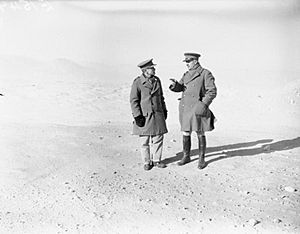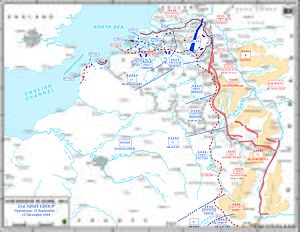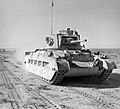Richard O'Connor facts for kids
Quick facts for kids
Sir Richard O'Connor
|
|
|---|---|
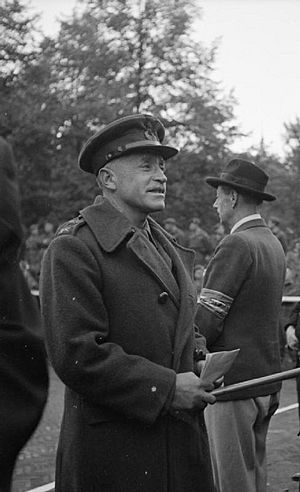 |
|
| Born | 21 August 1889 Srinagar, British India |
| Died | 17 June 1981 (aged 91) King Edward VII's Hospital, London, England |
| Allegiance | United Kingdom |
| Service/ |
British Army |
| Years of service | 1908–1948 |
| Rank | General |
| Service number | 936 |
| Unit | Cameronians (Scottish Rifles) |
| Commands held | Northern Command, India (1945–46) Eastern Command, India (1945) VIII Corps (1944) British Troops in Egypt (1941) XIII Corps (1941) Western Desert Force (1940–41) 6th Infantry Division (1939–40) 7th Infantry Division (1938–39) Peshawar Brigade (1936–38) 2nd Infantry Battalion, Honourable Artillery Company (1917–19) |
| Battles/wars | First World War Arab revolt in Palestine Second World War |
| Awards | Knight of the Order of the Thistle Knight Grand Cross of the Order of the Bath Distinguished Service Order & Bar Military Cross Mentioned in despatches (13) Legion of Honour (France) Croix de Guerre (France) Silver Medal of Military Valor (Italy) |
| Other work | Commandant of the Army Cadet Force, Scotland Colonel of the Cameronians Lord Lieutenant of Ross and Cromarty Lord High Commissioner to the General Assembly of the Church of Scotland |
General Sir Richard Nugent O'Connor (21 August 1889 – 17 June 1981) was an important British Army officer. He fought in both the First World War and the Second World War. During the Second World War, he led the Western Desert Force. This force achieved a huge victory in Operation Compass. His troops defeated a much larger Italian army in North Africa. This win almost pushed the Axis powers out of Africa. It also made Adolf Hitler send the famous Afrika Korps led by Erwin Rommel to the region.
O'Connor was captured by German soldiers in April 1941. He spent over two years as a prisoner of war in Italy. He managed to escape in 1943. In 1944, he commanded VIII Corps during the Battle of Normandy. He also served in Operation Market Garden. Later, he held important roles in India. He was recognized with many high honors for his service. These included two top levels of knighthood. He also received the Distinguished Service Order twice and the Military Cross.
Contents
Early Life and Military Start
Richard O'Connor was born in Srinagar, Kashmir, India, on August 21, 1889. His father was a major in the Royal Irish Fusiliers. His mother's father was a former governor in India. Richard went to Tonbridge Castle School and The Towers School. After his father's death, he attended Wellington College. He then went to the Royal Military College, Sandhurst in 1908.
In September 1909, he became a second lieutenant. He joined the 2nd Battalion, Cameronians (Scottish Rifles). He stayed connected to this regiment throughout his life. In 1910, his battalion moved to Colchester. There, he trained in signals and rifles. From 1911 to 1912, he was a signals officer in Malta.
First World War Service
During the First World War, O'Connor first served as a signals officer. He was part of the 22nd Brigade in the 7th Division. He became a captain leading the 7th Division's Signals Company. From October 1916, he served as a brigade major for the 91st Brigade.
He received the Military Cross in February 1915. He fought in battles at Arras and Bullecourt. In June 1917, he was awarded the Distinguished Service Order (DSO). He was also made a lieutenant-colonel. This was when he commanded the 2nd Infantry Battalion of the Honourable Artillery Company.
In November 1917, his division helped the Italians. They fought against Austro-Hungarian forces at the River Piave. In October 1918, his battalion captured the island of Grave di Papadopoli. For this, O'Connor received the Italian Silver Medal of Military Valor. He also got a second award (a Bar) for his DSO. After the war, he returned to his captain rank. He served as a regimental adjutant until December 1919.
Between the World Wars
O'Connor attended the Staff College, Camberley in 1920. From 1921 to 1924, he was a brigade major in the Experimental Brigade. This brigade tested new ways to use tanks and aircraft with infantry and artillery.
He returned to his old unit, the Cameronians (Scottish Rifles), from 1924 to 1925. From 1925 to 1927, he taught at Sandhurst. He then became an instructor at the Staff College, Camberley, until 1930. In the early 1930s, he served with the Cameronians in Egypt and India. From 1932 to 1935, he worked at the War Office.
In 1935, he attended the Imperial Defence College. In April 1936, he became a full colonel. He was made a temporary brigadier to command the Peshawar Brigade in India. In September 1938, O'Connor was promoted to major-general. He commanded the 7th Infantry Division in Palestine. He was also the Military Governor of Jerusalem. He was recognized for his work in Palestine.
In August 1939, just before the Second World War began, his division moved to Egypt. O'Connor was in charge of defending against a possible attack. This attack might come from the large Italian Tenth Army in Libya. His 7th Division became the 6th Division in November 1939. He received the Companion of the Order of the Bath in July 1940.
Second World War Campaigns
Operation Compass: A Great Victory
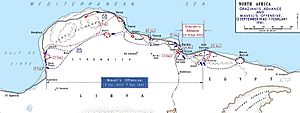
Italy declared war on Britain and France on June 10, 1940. Soon after, O'Connor became commander of the Western Desert Force. His mission was to push the Italian forces out of Egypt. He also had to protect the Suez Canal and British interests.
On September 13, the Italian army advanced into Egypt. They stopped at Sidi Barrani due to lack of supplies. O'Connor began to plan a counterattack. He had about 36,000 British and Commonwealth troops. The Italians had nearly five times as many soldiers. They also had many more tanks and artillery. Small groups from the 7th Armoured Division and Long Range Desert Group harassed the Italians. The Royal Navy and Royal Air Force also attacked enemy positions.
In November, O'Connor was made an acting lieutenant-general. This was because his command had grown larger.
The counterattack, named Operation Compass, started on December 8, 1940. O'Connor's force was small: 31,000 men, 275 tanks, and 120 artillery pieces. But they were well supported by the RAF and Royal Navy. They broke through Italian defenses at Sidi Barrani. The Desert Force moved quickly through Italian areas. They captured many strongpoints by cutting them off. The Italian guns could not stop the heavy British Matilda tanks. Their shells just bounced off the armor. By mid-December, the Italians were out of Egypt. They left behind 38,000 prisoners and lots of equipment.
The Desert Force rested briefly. Then they continued into Italian Libya. General Sir Archibald Wavell ordered the 4th Indian Division to leave. This experienced division was needed for an invasion in East Africa. The 6th Australian Division replaced them. This division was tough but new to desert fighting. Despite this, the attack continued. By December 6, the Australians captured Bardia. They took 40,000 more prisoners and 400 guns.
In January 1941, the Western Desert Force became XIII Corps. The attack continued on January 9. By January 12, the port of Tobruk was surrounded. On January 22, Tobruk fell. Another 27,000 Italian prisoners were taken. Valuable supplies, food, and weapons were also captured.
On January 26, the remaining Italian divisions in eastern Libya began to retreat. O'Connor quickly chased them. He sent his tanks through the desert to cut them off. The infantry chased them along the coast. The fast 4th Armoured Brigade reached Beda Fomm before the Italians on February 5. They blocked the main road, stopping the Italian escape. Two days later, the Italians surrendered. They had tried to break through but failed. O'Connor and Eric Dorman-Smith sent a famous message to Wavell: "Fox killed in the open..."
In just two months, XIII Corps had advanced over 800 miles (1,287 km). They destroyed an entire Italian army of ten divisions. They took over 130,000 prisoners, 400 tanks, and 1,292 guns. The British lost only 500 killed and 1,373 wounded. For this amazing victory, O'Connor was made a Knight Commander of the Order of the Bath.
Setbacks and Capture
The victory of Operation Compass was not complete. The Italians still controlled most of Libya. O'Connor wanted to push on to Tripoli to finish the fight. Wavell agreed. However, Churchill ordered the advance to stop. The Axis had invaded Greece. Wavell was told to send forces there. The 6th Australian Division and parts of the 7th Armoured Division were sent. XIII Corps HQ was closed. In February 1941, O'Connor became commander of British Troops in Egypt.
Things got worse for the British. By March 1941, Hitler sent General Erwin Rommel and the Afrika Korps to Libya. Wavell and O'Connor now faced a very skilled enemy. Rommel launched his own attack on March 31. The inexperienced 2nd Armoured Division was defeated. On April 6, O'Connor and Sir Philip Neame, another commander, were traveling. They were captured by a German patrol near Martuba.
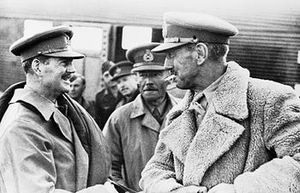
Prisoner of War and Escape
O'Connor spent two and a half years as a prisoner of war. He was mostly held at the Castello di Vincigliata near Florence, Italy. He was with other important officers like Sir Adrian Carton de Wiart. They formed an escape club. Their first attempt to climb the walls failed. They were put in solitary confinement for a month.
Their second attempt involved a tunnel. It was built between October 1942 and March 1943. Two New Zealand brigadiers, James Hargest and Reginald Miles, escaped to Switzerland. O'Connor and Carton de Wiart walked for a week. But they were captured near Bologna. Again, they spent a month in solitary confinement.
The final, successful escape happened after Italy surrendered in September 1943. With help from the Italian resistance movement, O'Connor, Neame, and another officer escaped. They were being moved from Vincigliati. After a failed meeting with a submarine, they reached Termoli by boat. Then they went to Bari. There, they were welcomed by General Sir Harold Alexander and American General Dwight D. Eisenhower. This was on December 21, 1943.
When O'Connor returned to Britain, he received the knighthood he was awarded in 1941. He was also promoted to lieutenant-general.
VIII Corps and Normandy Landings
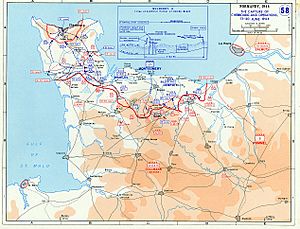
On January 21, 1944, O'Connor became commander of VIII Corps. This corps included the Guards Armoured Division, 11th Armoured Division, and 15th (Scottish) Infantry Division. VIII Corps was part of the British Second Army. This army was part of the 21st Army Group, led by General Sir Bernard Montgomery. O'Connor's corps would join Operation Overlord, the Allied invasion of German-occupied France. They were part of the second wave of landings.
On June 11, 1944, O'Connor and VIII Corps arrived in Normandy. They were near Caen, where much fighting would happen. O'Connor's first mission was Operation Epsom. This plan was to break out from a bridgehead. They would cross the Odon and Orne rivers. Then they would secure high ground and cut off Caen from the south. The breakout and river crossings were successful. Montgomery congratulated O'Connor and his corps. But cutting off Caen was much harder. VIII Corps was pushed back over the Orne. O'Connor tried to re-establish a bridgehead in Operation Jupiter. This had little success.
After being put in reserve on July 12, VIII Corps' next big action was Operation Goodwood. The attack began on July 18 with a huge air bombardment. It ended on July 20. The attack stopped in heavy rain, making the battlefield muddy. The main goals were not taken.
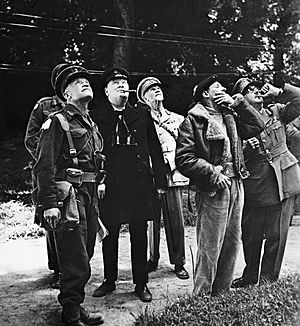
The corps was moved to the southwest of Caen for Operation Bluecoat. The 15th (Scottish) Division attacked towards Vire. This helped the American advance in Operation Cobra. There was fast movement followed by fierce fighting. Both sides suffered heavy losses.
As the Allies prepared to chase the Germans from France, VIII Corps was put in reserve. Its vehicles were used to supply other corps. O'Connor's command was reduced in mid-August. He kept in touch with Montgomery and others. He suggested improvements for armored vehicles. He also addressed problems like combat fatigue. Some of his ideas were used, like adding "rams" to vehicles. These helped with the difficult hedgerow country.
Later War Service and Retirement
O'Connor remained in command of VIII Corps. He supported Brian Horrocks' XXX Corps in Operation Market Garden. This was Montgomery's plan to create a bridgehead across the Rhine in the Netherlands. After entering Weert in September, VIII Corps prepared for Operation Aintree. This advance towards Venray and Venlo began on October 12.
However, on November 27, O'Connor was removed from his post. He was ordered to become commander of Eastern Command, India. This marked the end of his long combat career. But his new job was important. He controlled the supply lines for the Fourteenth Army. O'Connor was recognized for his service for the thirteenth and final time in March 1945.
In April 1945, he was promoted to full general. In October, he became commander of the North Western Army in India. From 1946 to 1947, he was Adjutant-General to the Forces. This role involved managing the British Army's administration and personnel. His time as adjutant general was short. He disagreed about cancelling demobilization for troops in the Far East. O'Connor resigned in September 1947. He was then made a Knight Grand Cross of the Order of the Bath.
O'Connor retired in 1948 at age 58. But he stayed involved with the army. He was Commandant of the Army Cadet Force in Scotland from 1948 to 1959. He was also Colonel of the Cameronians from 1951 to 1954. He served as Lord lieutenant of Ross and Cromarty from 1955 to 1964. In 1964, he was Lord High Commissioner to the General Assembly of the Church of Scotland. His first wife, Jean, died in 1959. In 1963, he married Dorothy Russell.
In July 1971, he was made a Knight of the Order of the Thistle. O'Connor was interviewed for the TV series The World at War. He spoke about operations in North Africa. Richard O'Connor died in London on June 17, 1981. He was almost 92 years old.
Images for kids
See also
 In Spanish: Richard O'Connor para niños
In Spanish: Richard O'Connor para niños



